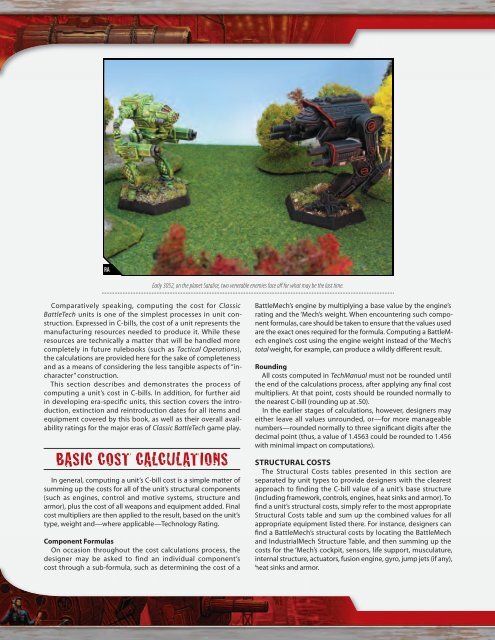the shape of things to come
the shape of things to come
the shape of things to come
Create successful ePaper yourself
Turn your PDF publications into a flip-book with our unique Google optimized e-Paper software.
RA RA<br />
Comparatively speaking, computing <strong>the</strong> cost for Classic<br />
BattleTech units is one <strong>of</strong> <strong>the</strong> simplest processes in unit construction.<br />
Expressed in C-bills, <strong>the</strong> cost <strong>of</strong> a unit represents <strong>the</strong><br />
manufacturing resources needed <strong>to</strong> produce it. While <strong>the</strong>se<br />
resources are technically a matter that will be handled more<br />
completely in future rulebooks (such as Tactical Operations),<br />
<strong>the</strong> calculations are provided here for <strong>the</strong> sake <strong>of</strong> completeness<br />
and as a means <strong>of</strong> considering <strong>the</strong> less tangible aspects <strong>of</strong> “incharacter”<br />
construction.<br />
This section describes and demonstrates <strong>the</strong> process <strong>of</strong><br />
computing a unit’s cost in C-bills. In addition, for fur<strong>the</strong>r aid<br />
in developing era-specifi c units, this section covers <strong>the</strong> introduction,<br />
extinction and reintroduction dates for all items and<br />
equipment covered by this book, as well as <strong>the</strong>ir overall availability<br />
ratings for <strong>the</strong> major eras <strong>of</strong> Classic BattleTech game play.<br />
BASIC COST CALCULATIONS<br />
In general, computing a unit’s C-bill cost is a simple matter <strong>of</strong><br />
summing up <strong>the</strong> costs for all <strong>of</strong> <strong>the</strong> unit’s structural components<br />
(such as engines, control and motive systems, structure and<br />
armor), plus <strong>the</strong> cost <strong>of</strong> all weapons and equipment added. Final<br />
cost multipliers are <strong>the</strong>n applied <strong>to</strong> <strong>the</strong> result, based on <strong>the</strong> unit’s<br />
type, weight and—where applicable—Technology Rating.<br />
Component Formulas<br />
On occasion throughout <strong>the</strong> cost calculations process, <strong>the</strong><br />
designer may be asked <strong>to</strong> find an individual component’s<br />
cost through a sub-formula, such as determining <strong>the</strong> cost <strong>of</strong> a<br />
Early 3052, on <strong>the</strong> planet Satalice, two venerable enemies face <strong>of</strong>f for what may be <strong>the</strong> last time.<br />
BattleMech’s engine by multiplying a base value by <strong>the</strong> engine’s<br />
rating and <strong>the</strong> ‘Mech’s weight. When encountering such component<br />
formulas, care should be taken <strong>to</strong> ensure that <strong>the</strong> values used<br />
are <strong>the</strong> exact ones required for <strong>the</strong> formula. Computing a BattleMech<br />
engine’s cost using <strong>the</strong> engine weight instead <strong>of</strong> <strong>the</strong> ‘Mech’s<br />
<strong>to</strong>tal weight, for example, can produce a wildly diff erent result.<br />
Rounding<br />
All costs computed in TechManual must not be rounded until<br />
<strong>the</strong> end <strong>of</strong> <strong>the</strong> calculations process, after applying any fi nal cost<br />
multipliers. At that point, costs should be rounded normally <strong>to</strong><br />
<strong>the</strong> nearest C-bill (rounding up at .50).<br />
In <strong>the</strong> earlier stages <strong>of</strong> calculations, however, designers may<br />
ei<strong>the</strong>r leave all values unrounded, or—for more manageable<br />
numbers—rounded normally <strong>to</strong> three signifi cant digits after <strong>the</strong><br />
decimal point (thus, a value <strong>of</strong> 1.4563 could be rounded <strong>to</strong> 1.456<br />
with minimal impact on computations).<br />
STRUCTURAL COSTS<br />
The Structural Costs tables presented in this section are<br />
separated by unit types <strong>to</strong> provide designers with <strong>the</strong> clearest<br />
approach <strong>to</strong> finding <strong>the</strong> C-bill value <strong>of</strong> a unit’s base structure<br />
(including framework, controls, engines, heat sinks and armor). To<br />
fi nd a unit’s structural costs, simply refer <strong>to</strong> <strong>the</strong> most appropriate<br />
Structural Costs table and sum up <strong>the</strong> combined values for all<br />
appropriate equipment listed <strong>the</strong>re. For instance, designers can<br />
fi nd a BattleMech’s structural costs by locating <strong>the</strong> BattleMech<br />
and IndustrialMech Structure Table, and <strong>the</strong>n summing up <strong>the</strong><br />
costs for <strong>the</strong> ‘Mech’s cockpit, sensors, life support, musculature,<br />
internal structure, actua<strong>to</strong>rs, fusion engine, gyro, jump jets (if any),<br />
heat sinks and armor.


